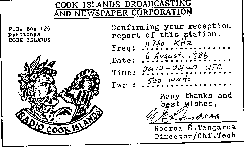Shortwave Radio
Internet and the World Wide Web now make it easier than ever to communicate anywhere almost instantly, at least for those with the resources to participate. However, radio remains a widely-used medium for people in many parts of the world. By bouncing or "skipping" back and forth between ionized layers in the atmosphere and the earth's surface, radio signals with frequencies in the shortwave bands (2 - 30 megahertz) can propagate around the globe.
Local stations from Peru to Papua New Guinea often have shortwave as well as medium-wave transmitters, and provide a great way for us in North America to enjoy their local music and culture. These stations often broadcast with a power not much above that of an ordinary light bulb, so picking them up can be a challenge. Much easier to hear are powerhouses such as the BBC, which has real, in-depth world news and high quality features.
Some shortwave listening (SWL)-related sites on the web:
- Bob Colyard's shortwave page, with logs, links, and access to Worldwide Utility Network pages.
- Shortwave/Radio Catalog (Pg 2) A voluminous compendium of useful SWL info., not a catalog of equipment.
- TRS Consultants page, Tom Sundstrom's comprehensive collection of info. and sites.
- USENET rec.radio.shortwave The SWL newsgroup.
- Cumbre DX, an e-mail DX newsletter which is one of the most helpful DX resources in existence for keeping up with latest DX news.
- World Utility Network home page, a great source for utility info. and loggings.
- Grove Enterprises, offerring new and used receivers plus publications.
- Dxtreme software, for logging and qsl's.
- North American Shortwave Association homepage.
- Georg Klingenfuss' homepage, with utility listings.
- Gerben's radio page An individual's page, with useful links.
- Shortwave Logs Page Mark Veldhuis posts some of his loggings here.
- Benelux DX Club A European SWL club.
- Tropical Band list (From BDXC) Broadcasts in the 3 - 5 MHz bands.
- Shortwave Radio Schedule Guide
Sample verification ("QSL") cards, received from Mongolia, Cook Islands, and Surinam:
 .....
..... .....
.....
 To Steve George's Home Page
To Steve George's Home Page
 To Steve George's Home Page
To Steve George's Home Page
 .....
..... .....
.....
 To Steve George's Home Page
To Steve George's Home Page